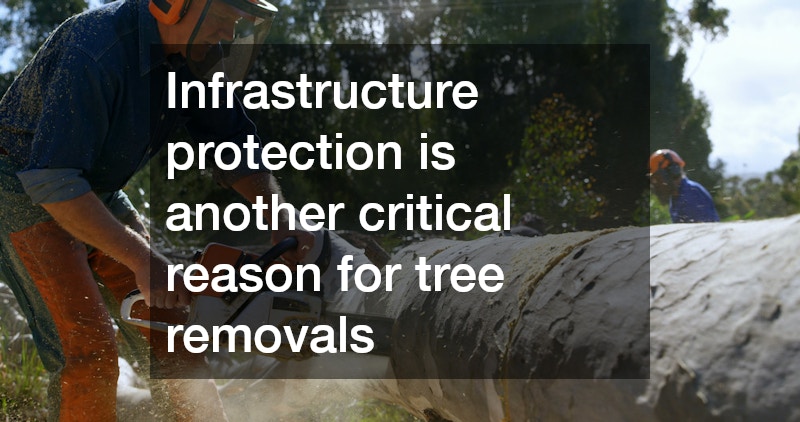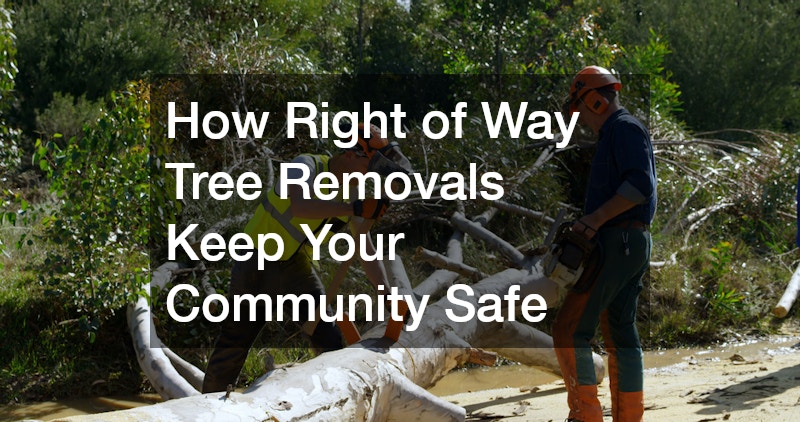Explore the importance of right of way tree removals in maintaining community safety, and learn the answers to common questions about the process, benefits, and implications of these actions.
What Are Right of Way Tree Removals?
Right of way tree removals involve the cutting down of trees that are located on public land, specifically along roads, pathways, or utility lines. Right of way tree removals play a critical role in the management of public spaces.
These trees, while valuable to the environment, can sometimes pose risks to infrastructure and safety. Understanding the parameters of such removals is essential for community members to grasp their importance.
Community safety is a collective responsibility, and right of way tree removals significantly influence the overall infrastructure and aesthetic of neighborhoods. When trees obstruct pathways or road visibility, their removal often becomes a necessary course of action to maintain safety and accessibility.
Additionally, right of way tree removals help to ensure that public utilities function without interruptions. Trees can grow into power lines or water pipes, causing hazards and service disruptions, making these removals a proactive approach to community safety.
Why Are These Removals Necessary?
There are several reasons for removing trees from rights of way, including safety concerns, infrastructure protection, and preventing power outages. The primary motivation for tree removal is often safety-related. Overgrown trees can present hazards such as falling branches, particularly during storms or high winds. Ensuring that such risks are mitigated is paramount for protecting residents and property.
Infrastructure protection is another critical reason for tree removals. Trees that encroach on roadways or sidewalks can create dangerous situations for pedestrians and drivers alike. By removing these trees, municipalities prioritize the safety and well-being of their residents while ensuring public access remains unobstructed.
Trees near power lines can disrupt service and lead to outages, especially during severe weather. When trees grow too close to utility lines, they pose a risk of causing power failures or safety hazards due to downed lines. Thus, tree removals are an essential practice to enhance community resilience against power outages.
How Does This Process Improve Community Safety?
Tree removals can prevent hazards such as fallen branches during storms, obstructed views for drivers, and interference with power lines. Fallen branches can cause significant hazards; heavy limbs may fall on cars, pedestrians, or obstruct travel routes during inclement weather. By removing trees that pose a potential risk, municipalities can effectively reduce the likelihood of such dangerous occurrences.
Obstructed views can lead to accidents, particularly at intersections or along busy roads. When trees block sight lines, drivers may not see oncoming traffic or pedestrians. Removing these trees improves visibility and can significantly enhance road safety for all users.
Moreover, interference with power lines can lead to dangerous situations, especially during severe weather. Trees that fall onto power lines can not only disrupt service but can also pose fire hazards. Therefore, systematic tree removal reduces these risks, promoting an environment that prioritizes safety.
What Is the Process of Tree Removal?
The tree removal process typically involves assessment, planning, and execution by local authorities. The tree removal process often begins with a comprehensive assessment conducted by local officials or arborists. This crucial evaluation entails determining the health and safety levels of existing trees. Trees assessed as hazardous or unhealthy become candidates for removal.
Once trees are identified for removal, planning takes place to ensure any impacts on the surrounding environment and community are minimized. This step often involves consulting with community members and stakeholders to provide transparency and gather input about the removal process.
Finally, the execution phase involves the actual removal of the trees, which is often carried out by specialized contractors. Ensuring proper techniques are used during tree cutting is vital for protecting adjacent trees and minimizing disturbances to the surrounding area.
What Should Residents Know About Tree Removal?
Residents often have questions regarding their rights, involvement in decision-making, and potential replacements for removed trees. Residents have the right to be informed about the tree removal policies in their community. Understanding these guidelines ensures that they are aware of why certain actions are taken and how they can contribute to the decision-making process.
Community engagement is essential for fostering trust and transparency between residents and local authorities. Many municipalities offer public forums or surveys regarding tree removals, presenting residents with an opportunity to voice their concerns and preferences.
Another crucial point is the consideration of replanting. Many tree removal policies include provisions for planting new trees, which can help to mitigate the environmental impact of removals. This approach not only retains the aesthetic quality of the neighborhood but also contributes to long-term environmental health.
Right of way tree removals are crucial for ensuring the safety and efficiency of community infrastructure. Understanding the rationale, process, and policies surrounding these removals can foster better community engagement and awareness.



